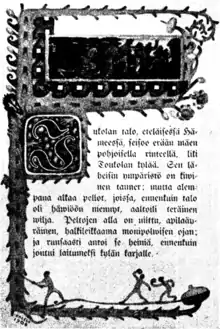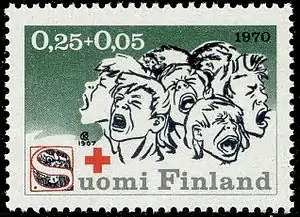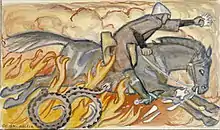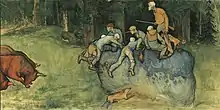Seitsemän veljestä
Seitsemän veljestä (Finnish for "seven brothers") is the first and only novel by Aleksis Kivi, the national author of Finland, and it is widely regarded as the first significant novel written in Finnish and by a Finnish-speaking author. Today, some people still regard it as the greatest Finnish novel ever written.[1]
 The first words of the novel in Finnish | |
| Author | Aleksis Kivi |
|---|---|
| Translator | Alex Matson, Richard Impola, Douglas Robinson |
| Country | Finland |
| Language | Finnish |
Publication date | 1870 |
Reception history
Published in 1870, Seitsemän veljestä ended an era dominated by Swedish-speaking authors, most notable of whom was J.L. Runeberg, and created a solid basis for new Finnish authors like Minna Canth and Juhani Aho, who were, following Aleksis Kivi, the first authors to depict ordinary Finns in a realistic way. Seitsemän veljestä has been translated three times into English, by Alex. Matson,[2] Richard Impola,[3] and Douglas Robinson;[4] and 56 more times into 33 other languages.[5]

The novel was particularly reviled by the literary circles of Kivi's time, who disliked the unflattering image of Finns it presented. The title characters were seen as crude caricatures of the nationalistic ideals of the time. Foremost in this hostile backlash was the influential critic August Ahlqvist, who called the book a "ridiculous work and a blot on the name of Finnish literature"[6] and wrote that the brothers' characters were nothing like calm, serious and laborious folk who toiled the Finnish lands.
Characters
Jukola brothers
- Juhani – the oldest brother, also the most stubborn
- Aapo – twin-brother of Tuomas, logical and peaceful
- Tuomas – scrupulous, strong as a bull, although Juhani claims to be the strongest brother
- Simeoni – alcoholic and the most religious brother
- Timo – twin-brother of Lauri, simple and earnest
- Lauri – the most solemn brother, friend of nature and a loner
- Eero – the youngest brother, intelligent, clever, quarrelsome when confronted by Juhani
Other
- Venla, a neighbor girl wooed by five of the seven brothers
Plot summary
At first, the brothers are not a particularly peaceful lot and end up quarreling with the local constable, juryman, vicar, churchwarden, and teachers—not to mention their neighbours in the village of Toukola. No wonder young girls' mothers do not regard them as good suitors. When the brothers are required to learn to read before they can accept church confirmation and therefore official adulthood—and the right to marry—they decide to run away.


Eventually they end up moving to distant Impivaara in the middle of relative wilderness, but their first efforts are shoddy—one Christmas Eve they end up burning down their sauna. The next spring they try again, but are forced to kill a nearby lord's herd of bulls and pay them back with wheat. Ten years of hard work clearing the forest for fields, hard drinking—and Simeoni's apocalyptic visions from delirium tremens—eventually lead them to mend their ways. They learn to read on their own and eventually return to Jukola.
In the end, most of them become pillars of the community and family men. Still, the tone of the tale is not particularly moralistic.[7]
Adaptations
The novel was adopted into a children's picture book with all the characters being changed into dogs or birds, which was named "The Seven Dog Brothers: Being a Doggerel Version of The Seven Brothers, Aleksis Kivi's Classic Novel from 1870".[8] The book was published in 2002 and is credited to Mauri Kunnas, a Finnish children's author, and Tarja Kunnas. Mr. Clutterbuck from "Goodnight, Mr. Clutterbuck" also by Mauri Kunnas makes an appearance in the story.[9]
In 1989 a TV series Seitsemän veljestä was produced by Jouko Turkka.
See also
References
- See e.g. Aarne Kinnunen, Tuli, aurinko ja seitsemän veljestä: Tutkimus Aleksis Kiven romaanista (“Wind, Sun, and Seven Brothers: A Study of AK’s Novel”), p. 8. Porvoo and Helsinki: WSOY, 1973.
- Aleksis Kivi, Seven Brothers. 1st edition, New York: Coward-McCann, 1929. 2nd edition, Helsinki: Tammi, 1952. 3rd edition, edited by Irma Rantavaara, Helsinki: Tammi, 1973. Note that Matson wrote his first name with the period ("Alex.") to indicate that it was a short form.
- Aleksis Kivi, Seven Brothers. New Paltz, NY: Finnish-American Translators Association, 1991.
- Aleksis Kivi, The Brothers Seven. Bucharest: Zeta Books, 2017
- Aleksis Kivi, the national author – web portal. See also Douglas Robinson, Aleksis Kivi and/as World Literature (Leiden and Boston: Brill, 2017).
- Liukkonen, Petri. "Aleksis Kivi". Books and Writers (kirjasto.sci.fi). Finland: Kuusankoski Public Library. Archived from the original on 28 August 2005.
- "Aleksis Kivi: Seitsemän veljestä". Jyväskylän yliopisto. 23 February 2017. Retrieved 21 August 2020.
- Link text,
- Kunnas, Mauri (21 May 2019). "Goodnight, Mr. Clutterbuck". Steerforth Press – via Google Books.
External links
| Wikimedia Commons has media related to Seitsemän veljestä. |
- The Aleksis Kivi Brothers Seven Translation Assessment Project, publicly accessible, provided by Hong Kong Baptist University Library
- http://www.seitsemanveljesta.net/